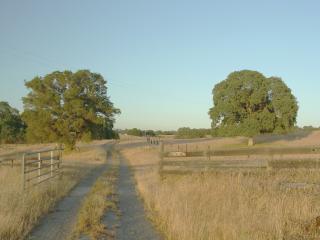 We are currently a bit confused regarding our oaks. Don't take the following very seriously.
We are currently a bit confused regarding our oaks. Don't take the following very seriously. We are currently a bit confused regarding our oaks. Don't take the following very seriously.
We are currently a bit confused regarding our oaks. Don't take the following very seriously.
The dominate tree on the ranch is the oak, two of which are seen alongside our entrance gate. We have Valley Oaks like the one on the left, and Blue Oaks like the one on the right. The trunks of Valley Oaks branch out near the ground while the Blue Oaks don't branch out until about 6-8 feet above the ground. Both lose their leaves in the winter. The grass under Live Oaks is not eaten to cattle, horses, and llamas.
There do not appear to be a sufficient number of young oaks to replace the existing mature trees in the pasture lands of the Sierra foothills. Perhaps they can't get started where there are a higher density of grazing animals, or more likely, human-caused reduction in bobcat and coyote populations have led to excessive ground squirrel populations which eat the acrons and can damage seedlings.
Valley Oak leaves, shown on the left, are simple in shape, but the Live Oak leaves, shown on the right, are scallopped and warped. Notice the small acorns growing amongst the Valley Oak leaves.
Here is a Live Oak seedling we started from an acorn and are protecting.
This large Mistletoe parasite is growing on a Live Oak.
Here is a SoapPlant and a close-up of its flower. It is a rarity, one of two growing along our driveway. This year is the first time one has bloomed. We keep this one protected in a wire cage.
This plant was used by local Indian tribes who dug up the root and used it for washing baskets. The fiberous root becomes soapy when wet and the Indians fashioned it into a brush with a handle.
This quite beautiful plant is Jimson Weed. It has a large, elegant, fragrant white flower (about 8" long) and florishes in the summer after the grasses have died. It is a member of the poisonous Datura family and therefore left alone even when food is scarce. The large Sphinx moth, however, lays its eggs in Jimsom weed and its hornworm caterpillars (the ones that love tomato plants) can feast on it.
Last updated: November 24, 2007
Contact Craig Van Degrift if you have problems or questions with this web site.